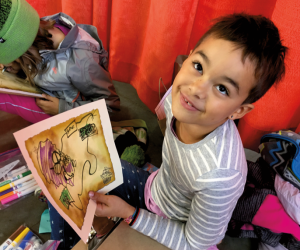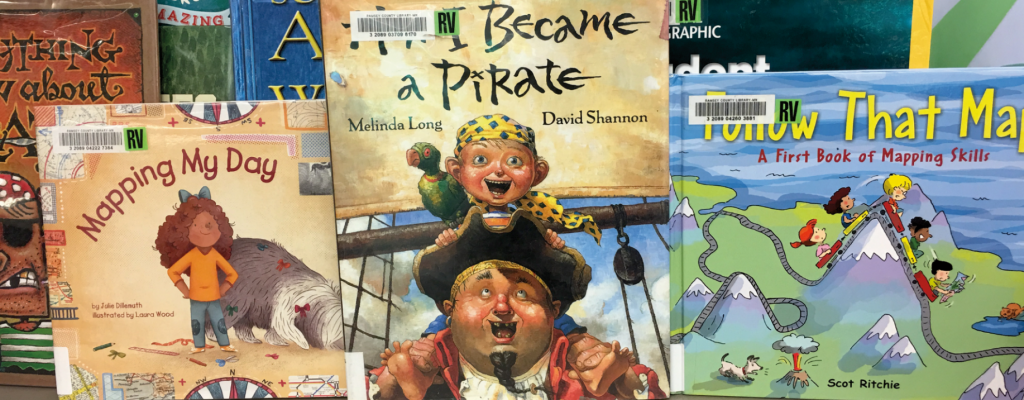6 Maps
Note: This chapter may seem repetitious. It is! This is intentional. In Chapter 5, I’m modeling my approach. The following chapters describe Writing Box Workshop programs, and include descriptions of the pedagogical underpinnings of each thematic program along with lists of materials, mentor texts, and prompts. The book is structured so that the librarian, the writing mentor, can open to a program and have everything they need as well as a checklist of what to do. We know we learn from repetition. Perhaps, I should have titled this chapter “Maps, again!”
Why Maps?
In 1916, Lucy Sprague Mitchell founded the Bureau of Educational Experiments, which later became Bank Street College of Education. Mitchell was a disciple of John Dewey and a proponent of experiential learning. Accordingly, Bank Street instructors took an innovative approach to teaching and learning; their students were taught to find opportunities to develop their own curricula. Teachers were also encouraged to take children into the neighborhood to explore local businesses, animals, plants, and events. During those trips, teachers discovered that making maps was the perfect way for children to process and communicate their experiences. In her book Young Geographers: How They Explore the World and How They Map the World, Mitchell encouraged those who work with children ages 5–12 to integrate map making into most subjects. We can make maps of the human body, of the library, of the neighborhood, of mythical kingdoms, and of literary landscapes.

When I was reading Kate DiCamillo’s Because of Winn-Dixie aloud, it was a natural progression to ask the students to create a map of the neighborhood that the protagonist, India Opal Buloni, explores throughout the story. Having students make maps is also a creative way to assess their comprehension of the material.
What do we need to know?
MAP: A graphic representation of selected characteristics of a place, usually drawn to scale on a flat surface.
CARTOGRAPHER: A person who makes maps.
The acronym DOGSTAILS makes it easy to remember the important parts of a map:
A map can tell you when it was made or updated (date), which direction is north (orientation), how to find places on it (grid), how distances on the map relate to distances on the ground (scale), what it is about (title), who made it (author), what the symbols mean (legend or key), where to find selected places on it (index), and where the map’s information comes from (sources or credits).
Not every map contains each of these elements, but they are things to think about when you’re making a map.

Mentor Texts
Barner, Bob. 1998. Which Way to the Revolution? A Book About Maps. 1st ed. 1 vols. New York: Holiday House.
Fanelli, Sara. 1995. My Map Book. 1st American ed. 1 vols. New York: HarperCollins Publishers.
Hartman, Gail, and Harvey Stevenson. 1991. As the Crow Flies : A First Book of Maps. 1st American ed. New York: Bradbury Press.
Hawkins, Colin, and Jacqui Hawkins. 2007. Pirate Treasure Map : A Fairytale Adventure. 1st U.S. ed. 1 vols. Cambridge, Mass.: Candlewick Press.
Hennessy, B. G., and Peter Joyce. 2004. The Once Upon a Time Map Book : Come on a Tour of Six Magical Once Upon a Time Lands. 2nd ed. 1 vols. Cambridge, Mass.: Candlewick Press.
Hughes, Susan, and Willow Dawson. 2008. No Girls Allowed: Tales of Daring Women Dressed as Men for Love, Freedom and Adventure: Kids Can Press.
Long, Melinda, and David Shannon. 2003. How I Became a Pirate. 1st ed. 1 vols. San Diego: Harcourt.
Merritt, Ed, Andrea Mills, and Anne Millard. 2008. Atlas of Exploration. New York: DK Pub.
Mizielińska, Aleksandra, and Daniel Mizieliński. 2013. Maps. Somerville, MA: Candlewick Press,.
Ross, Stewart, and Stephen Biesty. 2011. Into the Unknown: How Great Explorers Found Their Way by Land, Sea, and Air. 1st U.S. ed. Somerville, Mass.: Candlewick Press.
Shulevitz, Uri. 2008. How I Learned Geography. 1st ed. 1 vols. New York: Farrar Straus Giroux.
Walters, Virginia, and S. D. Schindler. 1999. Are We There yet, Daddy? 1 vols. New York: Viking.
Resources
Chohan, Sukhdeep Kaur. 2011. “Any Letter for Me? Relationships between an Elementary School Letter Writing Program and Student Attitudes, Literacy Achievement, and Friendship Culture.” Early Childhood Education Journal 39 (1):39-50.
Chua, Boon Liang. 2008. “Harry Potter and the Coding of Secrets.” Mathematics Teaching in the Middle School 14 (2):114-121.
Jackson, Roberta M. 1992. “The Untapped Power of Student Note Writing.” Educational Leadership 49 (7):54-58.
LeVine, Judith E. 2002. “Writing Letters to Support Literacy.” The Reading Teacher 56 (3):232.
Mitchell, Lucy Sprague. 1963. Young Geographers; How They Explore the World & How They Map the World. New York: Basic Books.
Rothschild, D. Aviva. 1995. Graphic Novels: A Bibliographic Guide to Book-Length Comics. Englewood, Colo.: Libraries Unlimited.

